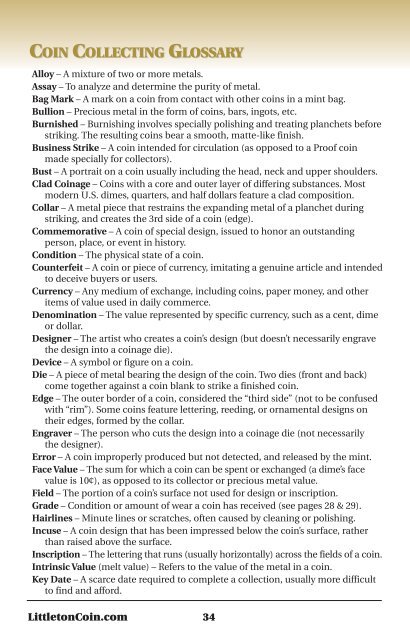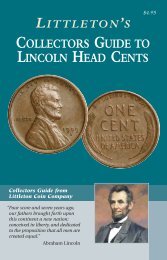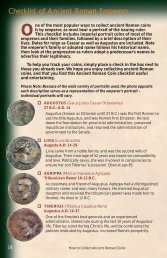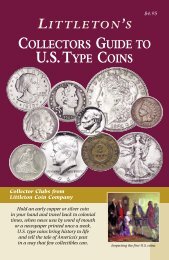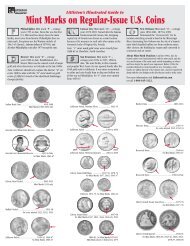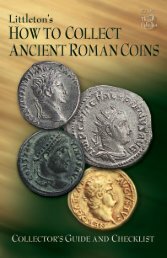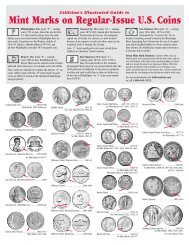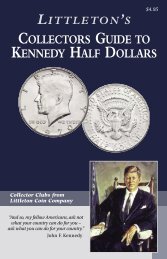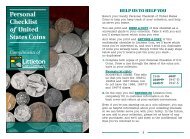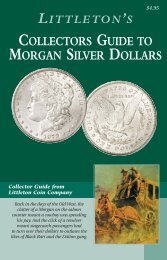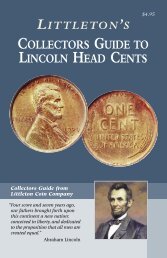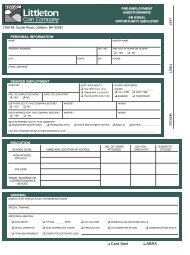COLLECT COINS COLLECT COINS - Littleton Coin Company
COLLECT COINS COLLECT COINS - Littleton Coin Company
COLLECT COINS COLLECT COINS - Littleton Coin Company
- No tags were found...
You also want an ePaper? Increase the reach of your titles
YUMPU automatically turns print PDFs into web optimized ePapers that Google loves.
COIN<br />
<strong>COLLECT</strong>ING<br />
GLOSSARY<br />
Alloy – A mixture of two or more metals.<br />
Assay – To analyze and determine the purity of metal.<br />
Bag Mark – A mark on a coin from contact with other coins in a mint bag.<br />
Bullion – Precious metal in the form of coins, bars, ingots, etc.<br />
Burnished – Burnishing involves specially polishing and treating planchets before<br />
striking. The resulting coins bear a smooth, matte-like finish.<br />
Business Strike – A coin intended for circulation (as opposed to a Proof coin<br />
made specially for collectors).<br />
Bust – A portrait on a coin usually including the head, neck and upper shoulders.<br />
Clad <strong>Coin</strong>age – <strong>Coin</strong>s with a core and outer layer of differing substances. Most<br />
modern U.S. dimes, quarters, and half dollars feature a clad composition.<br />
Collar – A metal piece that restrains the expanding metal of a planchet during<br />
striking, and creates the 3rd side of a coin (edge).<br />
Commemorative – A coin of special design, issued to honor an outstanding<br />
person, place, or event in history.<br />
Condition – The physical state of a coin.<br />
Counterfeit – A coin or piece of currency, imitating a genuine article and intended<br />
to deceive buyers or users.<br />
Currency – Any medium of exchange, including coins, paper money, and other<br />
items of value used in daily commerce.<br />
Denomination – The value represented by specific currency, such as a cent, dime<br />
or dollar.<br />
Designer – The artist who creates a coin’s design (but doesn’t necessarily engrave<br />
the design into a coinage die).<br />
Device – A symbol or figure on a coin.<br />
Die – A piece of metal bearing the design of the coin. Two dies (front and back)<br />
come together against a coin blank to strike a finished coin.<br />
Edge – The outer border of a coin, considered the “third side” (not to be confused<br />
with “rim”). Some coins feature lettering, reeding, or ornamental designs on<br />
their edges, formed by the collar.<br />
Engraver – The person who cuts the design into a coinage die (not necessarily<br />
the designer).<br />
Error – A coin improperly produced but not detected, and released by the mint.<br />
Face Value – The sum for which a coin can be spent or exchanged (a dime’s face<br />
value is 10¢), as opposed to its collector or precious metal value.<br />
Field – The portion of a coin’s surface not used for design or inscription.<br />
Grade – Condition or amount of wear a coin has received (see pages 28 & 29).<br />
Hairlines – Minute lines or scratches, often caused by cleaning or polishing.<br />
Incuse – A coin design that has been impressed below the coin’s surface, rather<br />
than raised above the surface.<br />
Inscription – The lettering that runs (usually horizontally) across the fields of a coin.<br />
Intrinsic Value (melt value) – Refers to the value of the metal in a coin.<br />
Key Date – A scarce date required to complete a collection, usually more difficult<br />
to find and afford.<br />
<strong>Littleton</strong><strong>Coin</strong>.com 34


